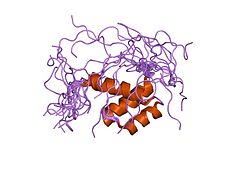Function
With an average worldwide prevalence of 1/800 live births, oral clefts are one of the most common birth defects. [8] Although over 300 malformation syndromes can include an oral cleft, non-syndromic forms represent about 70% of cases with cleft lip with or without cleft palate (CL/P) and roughly 50% of cases with cleft palate (CP) only. Non-syndromic oral clefts are considered 'complex' or 'multifactorial' in that both genes and environmental factors contribute to the etiology. Current research suggests that several genes are likely to control risk, as well as environmental factors such as maternal smoking. [9]
Re-sequencing studies to identify specific mutations suggest several different genes may control risk to oral clefts, and many distinct variants or mutations in apparently causal genes have been found reflecting a high degree of allelic heterogeneity. Although most of these mutations are extremely rare and often show incomplete penetrance (i.e., an unaffected parent or other relatives may also carry the mutation), combined they may account for up to 5% of non-syndromic oral cleft. [9]
Mutations in the SATB2 gene have been found to cause isolated cleft palates. [10] SATB2 also likely influences brain development. This is consistent with mouse studies that show SATB2 is necessary for the proper establishment of cortical neuron connections across the corpus callosum, despite the apparently normal corpus callosum in heterozygous knockout mice. [11]
Clinical significance
SATB2 has been implicated as causative in the cleft or high palate of individuals with 2q32q33 microdeletion syndrome. [11]
SATB2 was found to be disrupted in two unrelated cases with de novo apparently balanced chromosome translocations associated with cleft palate and Pierre Robin sequence. [12]
The role of SATB2 in tooth and jaw development is supported by the identification of a de novo SATB2 mutation in a male with profound intellectual disabilities and jaw and tooth abnormalities and a translocation interrupting SATB2 in an individual with Robin sequence. In addition, mouse models have demonstrated haploinsufficiency of SATB2 results in craniofacial defects that phenocopy those caused by 2q32q33 deletion in humans; moreover, full functional loss of SATB2 amplifies these defects. [11]
SATB2 expression is highly specific for cancer in the lower GI-tract and has been implicated as a cancer biomarker for colorectal cancer. [13] [14]
This page is based on this
Wikipedia article Text is available under the
CC BY-SA 4.0 license; additional terms may apply.
Images, videos and audio are available under their respective licenses.






